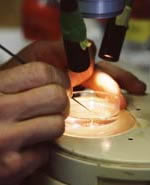
|
View MMA Documentary Video Series
|
 |
MMA Research Perspectives All MMA and OAA families, I wanted to write a quick note to forward the link of a major research publication from the NIH team ( Randy Chandler, PhD candidate and Charles Venditti MD, PhD) that has shown, for the first time, that a gene therapy can be used to treat methylmalonic acidemia. The paper is freely available at the following links: www.nature.com/mt/journal/vaop/ncurrent/full/mt2009247a.html or The researchers were able to effectively "cure" the MMA mice using gene therapy. The team engineered a highly effective virus to express the gene and then injected the mice immediately after birth. They showed that 26/27 or greater than 95% of the treated mice live for more than 1 year - this is the equivalent of living to ~30 years for a person. When untreated, the MMA mice that did not receive the gene therapy had a 100% chance of dying. They also used a non-invasive technique that relies on carbon dioxide production by the mice to track the efficacy of gene therapy by capturing and analyzing expired breaths from the treated mice. You can read the paper for details. Because the type of virus (AdenoAssociated Virus, or AAV) used by the team has been successfully given to humans, many hundreds of times, without any adverse event, there is now great promise that gene therapy may be used to treat some of the children with Mut MMA. There are implications for other disorders as well. (Great news for all OAA families) A quote from the end of the paper: "Our studies are the first to demonstrate that methylmalonic acidemia, and by extension other organic acidemias, might be treated by gene therapy with a safe and effective vector. This conclusion offers strong support for the continued and expanded screening of infants for disorders of intermediary metabolism and to the application of gene therapy to humans with methylmalonic acidemia." This accomplishment is monumental in the path towards a cure for MMA, in our children, and I would be remiss if I did not express gratitude to several groups of folks. First, I'd like to thank every person who supported the MMA Research Fund over the years. As a small grass roots fund we have managed to raise in the order of a half million dollars over a nine year period. Our collective efforts directly supported and effected the results being communicated today. Second, Dr. Venditti's research team, including Randy Chandler, who's combined dedication, innovation, and ingenuity has been instrumental in this accomplishment. And last and most importantly, Dr. Venditti. Words cannot express the level of gratitude and appreciation for what he has done. At cross roads in his life there were many more attractive (and I'm confident more lucrative) options along the way. Ten years ago he made a commitment to finding a cure for MMA. A 130 mile family move, three children, many, many weekends, and too many late nights to mention (running into the office to check on mice in the middle of the night) he has never wavered on his commitment. And amazingly, he does all this for no one but our kids. Few people in this world are as admirable as he. Thank you seems to trivial, but thank you from the bottom of our hearts and congratulations on this milestone! Martin Moran Perspectives on MMA Research: Toward the Development of an Animal Model for Methylmalonyl The clinical syndrome of severe methylmalonic acidemia was first described in the late 1960s by two independent groups. Since that time, there have been a number of clinical papers describing the natural history of some of the types of MMA as well as reports that have focused on the basic biochemistry, genetics and physiology of methylmalonyl coA mutase deficiency, the cause of mut-type MMA. Researchers who study mut-type MMA have been able to gain great insight into the nature of mutations (deleterious changes) in the mutase gene because of the investigations carried out over the past decade. While there has been excellent biochemical research on methylmalonyl coA mutase deficiency, a genetics milestone in MMA research came in the late 1980s when Dr. Fred Ledley and his co-workers were able to isolate the methylmalonyl coA mutase gene from human and mouse cells, identify the genomic location of the gene in both species and describe certain mutations that caused muto and mut- types of MMA. This research has been expanded over the past 10 years to include descriptions of many other mutations that cause mut-type MMA and some laboratories have continued to meticulously study the biochemical properties that these changes have on the mutant enzymes. What next? One priority will also be the description of animal models that might mimic the effects of the human disease. Such animals will be crucial to the testing of therapies, including gene therapies, and to the understanding of the pathophysiology (specifically what causes the disease) of the types of MMA. What this means in practice is that a mouse, rat, rabbit, chicken, cat or dog that suffers from MMA either needs to be identified or created. In parallel, more “primitive” organisms, such as yeast, flies, and worms, should also be studied because genetic manipulations are much easier with these creatures. Because there has been no natural animal model for MMA described to date, one must be developed; this endeavor is known as "creating a knock-out" mouse. When people talk about "knock-out" mice, they are describing animals that usually were created, in part, in the laboratory. Knock-out mice are made using genetic engineering and animal cloning methods. To make a knock-out mouse, an investigator usually starts by cloning the genomic copy of the gene of interest from a specific mouse strain called 129/Sv. The gene of interest is then modified by genetic engineering with drug-resistance markers to create a targeting vector that is then introduced into embryonic stem cells. Embryonic stem cells are cells that have retained a primitive character and have the ability to "become" another mouse. These cells can be grown in a cell-culture dish and manipulated like other cell lines. After the engineered mouse gene is added to the embryonic stem cells, a toxic drug (neomycin) is added to the cell culture media. Some of the drug-resistant cells in the dish will have the copy of the natural gene replaced with the modified gene. These bundles of drug-resistant cells can be individually picked from the culture plate and expanded for analysis. A very small fraction will have a specific disruption in the gene of interest and these rare cells will be the ones used to create a chimeric or mixed mouse. The properly targeted cells are then injected into a primitive embryo, harvested from a pregnant mouse. The injected embryo is then re-implanted into a different female that had been mated with a vasectomized male. When the surrogate mother gives birth, chimeric or mixed mice are easy to detect because the have a spotted or grayish appearance. This is because the modified embryonic stem cells were derived from a mouse with a white coat but injected into an embryo that has a black coat. The streaks or spots seen in the fur represent populations of cells derived from the modified, injected cells. Some of these primitive cells will have populated the reproductive organs in the mixed animal and can contribute to the sperm and eggs made by the animal. After a round of breeding, the chimeric animals can be assessed in their ability to transmit the engineered gene. The first generation offspring derived from the chimeras can then be mated to each other. 25% of the offspring in the next generation litter will be expected to inherit both modified genes (one from the mother and one from the father). It is this animal that actually is the "knock-out" mouse and as you may be able to infer from reading the above, making a knock-out mouse is time and labor intensive. The scientific gain derived from making a knock-out can be exceptional. Once an animal is established, the targeted mutation can be perpetually propagated in the heterozygous state and controlled matings can continue to produce mice that will inherit two mutant genes. We have initiated these types of studies with the mouse methylmalonyl coA mutase gene with the hope of producing mice that will develop muto-MMA. Pitfalls and Possible Solutions Future Directions
|
|

